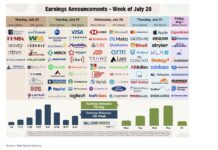Some would say (read: my wife) that I’m a creature of habit. However, I think that having consistency with your investment routine creates a culture of success. It allows you to continually act on what works and avoid straying from a predesigned plan of attack.
One of my habits is to write an annual review of the lessons I learned over the preceding twelve months. The purpose is to impart both successes and missteps in a way that bolsters your own investment endeavors. Many of these lessons are ones that I continue to re-learn or emphasize every single week.
How we start ≠ how we finish.
If you remember way back in February, the headlines were all about how this was the worst start to the year in the history of the stock market. Through last week, the SPDR S&P 500 ETF (NYSEARCA:SPY) is +13% year-to-date and up over 22% since the February lows. Just because the market starts out in a bad place, doesn’t mean it’s going to end up in one.
The same philosophy should also be adopted for each investor as well. If you got off to a bad start this year or were caught wrong-footed at some point along the way, what did you do to adapt?
I always recommend looking back over those perilous moments and review what you did right or wrong. That way you can lean on the same strengths or become self-aware of your weaknesses when a similar event occurs in the future. Believe me, it’s going to happen again at some point.
Things are never as good or as bad as you think they are.
The media headlines always live on the extremes. This is either the greatest market opportunity in the history of the world or the biggest exuberant bubble that is moments away from popping. The truth is usually much more nuanced and moderate, but temperance doesn’t drive clicks and eyeballs.
If you find yourself riding the emotional swings of your portfolio changes or CNBC every day, take a step back and evaluate that perspective. There is usually very little to be gained by becoming overly enthusiastic or pessimistic. It clouds your judgement and leads to behavioral missteps.
This is one of the reasons I always keep a balanced and diversified asset allocation. It allows me to offset certain risks with a sensible structure that can be incrementally shifted as needed to take advantage of the prevailing conditions.
 A counter-intuitive mindset is still your greatest ally.
A counter-intuitive mindset is still your greatest ally.
This continues to be a re-occurring theme throughout my weekly articles and annual review pieces. Sentiment and turning points are always tough to gauge because trends can extend much farther than most think possible. However, there are logical ways to slowly reduce your exposure to overbought areas and similarly add to oversold ones. You may not hit the nail perfectly on the head, but it’s a hell of a lot better strategy than chasing performance after the move has already been made.
This approach led us to make the switch out of minimum volatility ETFs half-way through 2016. It’s also why we became cautious on long and intermediate-duration bonds near the mid-way point of the year. We don’t perfectly time tops or bottoms. No one can. However, these subtle shifts allowed us to adjust our risk profile and capitalize on new opportunities when everyone else was looking the other direction.
Valuation is a terrible timing mechanism.
Stop me if you have heard this one…. “I’m going to hold off on doing anything because stocks are expensive here relative to historical norms”. The CAPE ratio guys find it especially difficult to apply their logic to the market when valuations become stretched for extended periods.
However, there are many examples of stocks that continue to defy the law of averages. How long have Amazon and Netflix been expensive? How will the influences of this bull market cycle differ from past runs?
Just because something looks expensive in a historical sense doesn’t mean it can’t become more so. The same law applies to selling on the downside. Cheap can always get cheaper until it hits ground zero.
The psychology of investing is one that can see long stretches of seemingly irrational behavior. That doesn’t mean you should just fold up shop and fail to participate based on an arbitrary statistic. Make sure that your portfolio strategy is more sensible than simply relying on P/E metrics and other subjective data comparisons.
Cash creates anxiety on the upside.
The only thing worse than being over-invested on the way down is being under-invested on the way up. That is the case with many investors I talk to these days. They have so been terrified of making a mistake and mistiming the market, that they have remained in cash for a VERY long time. Quite a few are still frozen with indecision as the market continues to burn through their psychological capital on its march higher.
The problem now is when do you get back in? On a 5% or 10% dip? What if the market moves 10% higher from right here and then falls? You just end up putting money to work right where you made that mental commitment. It’s not a perfect science and the timing is tough to get just right.
The first step is creating a game plan that you are comfortable with – even if that means turning your portfolio over to someone else you trust to do it for you. There are no guarantees that they will get it right initially either. However, letting go of some fear and realizing that you need to make a change can be a positive step in the right direction. Make sure you come to terms that there will be losses, but they can be mitigated through a diversified or risk-aware investment philosophy.
A simple approach is the best approach.
I can’t emphasize this one enough. Keep. It. Simple.
This entire month, I have been reading about median hedge fund returns notching another unimpressive year. Long/short, macro, and fund-of-funds have especially taken a beating relative to common-sense benchmarks. Many shops so badly that they are having to close and return capital to investors because their performance is atrocious. These billion-dollar firms are run by some of the smartest people in the world. How could they possibly perform to such standards?
The answer is that they are over-complicating everything. They are trying to out-think every single asset class with the world’s most sophisticated algorithms and advanced tools. They are also hindered by a tremendous drag in ongoing management and performance fees.
I’m an advocate for active management. However, I think that it can be done on a reasonable scale and with low-cost tools to achieve better results. Complex isn’t better. It just gives you more components to worry about and creates head-scratching performance.
The Final Word
I want to personally thank all our loyal readers who have been so supportive over the last several years. It’s been a pleasure interacting and drawing ideas from our conversations. I look forward to a successful 2017 and wish you all a healthy and wealthy New Year.
Twitter: @fabiancapital
Read more on Dave’s Blog.
Any opinions expressed herein are solely those of the author, and do not in any way represent the views or opinions of any other person or entity.








